The fertilizer industry produces essential nutrients for agriculture, such as nitrogen, phosphorus, and potassium-based fertilizers. Key processes include ammonia, urea, and phosphoric acid production. These processes involve handling hazardous chemicals, releasing gases like ammonia, nitrogen oxides, and VOCs. Effective gas leak detection ensures safety and environmental protection.
The Fertilizer industry encompasses several processes. Here are some of the key processes in the fertilizer industry:
- Ammonium Nitrate Production
- Phosphoric Acid Production (Wet Process)
- Ammonia Production (Haber-Bosch Process)
- Nitric Acid Production (Ostwald Process)
- Urea Production
- Sulfuric Acid Plant
- Air Separation Units
- Fertilizer Formation
- Coating and Slow-Release Formulations
- Drying and Cooling
- Utility Generation and Supply Systems
- Gas Scrubbers & Waste Gas Treatment Units
- Packaging and Storage and Handling
- Wastewater & Effluent Treatment Units
- Waste Handling and Environmental Control
Ammonium Nitrate Production
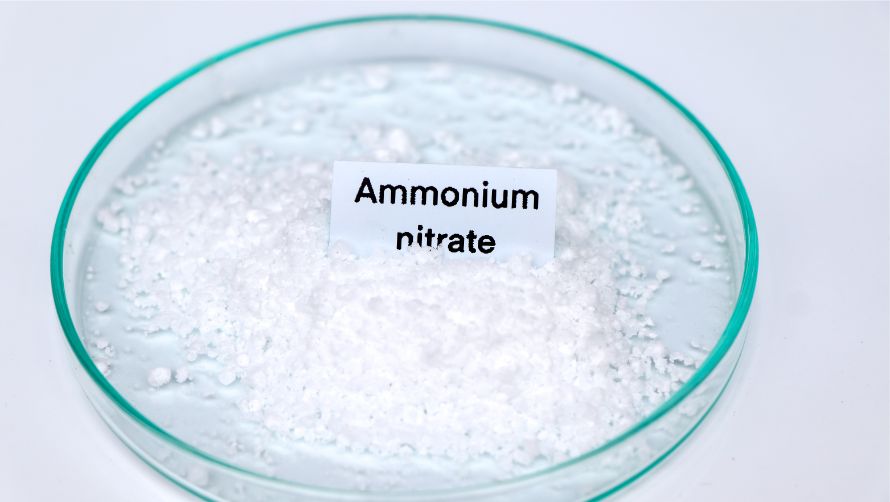
Ammonium nitrate (NH₄NO₃) production is a major process in the fertilizer industry, primarily used for manufacturing nitrogen-based fertilizers. The process involves the neutralization of nitric acid (HNO₃) with anhydrous ammonia (NH₃), producing an exothermic reaction that forms a hot ammonium nitrate solution. This solution is then concentrated through evaporation and subsequently solidified into prills or granules via prilling towers or granulators. The solid ammonium nitrate is then cooled, coated to reduce caking, and stored under controlled conditions due to its explosive potential. Safety, temperature control, and ventilation are critical in this process to minimize the risk of detonation and toxic gas exposure.
Types of Gases Present
Ammonia (NH3):Toxic, corrosive, and pungent; causes respiratory irritation.
Nitrogen Oxides (NOx) : Toxic, reddish-brown gases (mainly NO and NO₂); cause eye/lung irritation and contribute to smog.
Nitric Acid Vapors (HNO3) : Corrosive and irritating; exposure may damage respiratory tract.
Hydrogen (H2) : May form during byproduct reactions; flammable and explosive in air.
Carbon Dioxide (CO2) : Asphyxiant; may be present in minor quantities during evaporation and combustion steps.
Neutralizer Reactor (Ammonia & Nitric Acid Mixing)
High-risk zone where ammonia and nitric acid react; leaks can result from gasket failures or valve leaks.
Fixed Point Detectors: Install NH3 and NOx detectors around the neutralizer, pipelines, and mixing chambers.
Portable Detectors: NH3 and NO2 detectors used during startup, inspections, and flange maintenance.
Evaporators & Concentrators
Elevated temperatures and acidic environment can corrode parts, leading to vapor or gas emissions.
Fixed Point Detectors: NOx and HNO3 vapor detectors near vents, drains, and evaporator vessels.
Portable Detectors: HNO3 sensors for internal inspections and during concentrated solution handling.
Prilling Tower or Granulator Units
Mist, fine particulate, and residual vapors may be released; especially during malfunctioning cooling systems.
Fixed Point Detectors: NOX and NH3 detectors around tower base, air outlets, and elevator conveyors.
Portable Detectors :Used during tower access, maintenance, or blockage clearing activities.
Storage Tanks
Leaks may occur from tank nozzles, pressure relief valves, or during transfer operations.
Fixed Point Detectors: NOX and NH3 detectors installed around tank perimeters and transfer stations.
Portable Detectors : Essential during loading/unloading and valve inspections.
Phosphoric Acid Production (Wet Process)
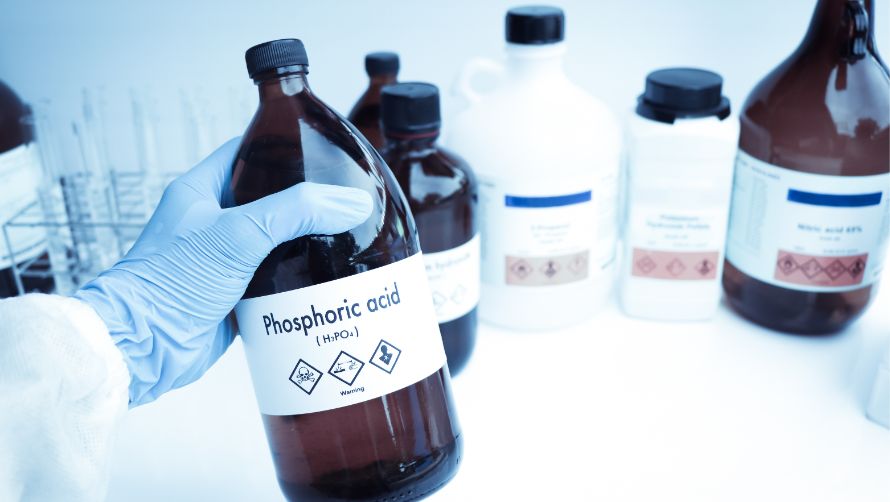
The wet process for phosphoric acid production involves the reaction of phosphate rock with sulfuric acid to produce phosphoric acid and calcium sulfate (gypsum) as a byproduct. The process occurs in large reaction vessels, where finely ground phosphate rock is mixed with sulfuric acid, typically in a concentrated form. This reaction generates phosphoric acid (H₃PO₄), which is then purified and concentrated before being used in the production of fertilizers. The byproduct, calcium sulfate, is filtered out and often disposed of or used in construction. The process typically operates at moderate temperatures (70–100°C) and pressures (1–5 bar), requiring efficient handling of gases and liquids.
Types of Gases Present
Ammonia (NH3): Released in small quantities from fertilizers and other materials used in the process.
Phosphine (PH3) : Toxic, highly flammable, emitted during certain chemical reactions.
Sulfur Dioxide (SO2) : Toxic, pungent, and corrosive; released when sulfuric acid comes into contact with phosphate rock.
Hydrogen Sulfide (H2S) : Toxic, flammable, and produced during certain reactions, especially if impurities are present in phosphate rock.
Fluorides (HF, SiF4) : Harmful and corrosive gases released from phosphate rock or sulfuric acid handling.
Carbon Dioxide (CO2): Asphyxiant in high concentrations, emitted during sulfuric acid production and certain reaction stages.
Phosphate Rock Handling and Mixing
Dust and gases such as fluorides and ammonia may be emitted during phosphate rock mixing with sulfuric acid.
Fixed Point Detectors: Install HF, NH₃, and dust detectors near mixing units, conveyors, and hoppers.
Portable Detectors: Used by operators during maintenance, visual inspections, and for confined space entry checks.
Reactor Vessels and Acid Handling
High acid concentrations and the reaction between phosphate rock and sulfuric acid can cause leaks of sulfur dioxide (SO₂) and hydrogen sulfide (H₂S).
Fixed Point Detectors: Install SO₂ and H₂S detectors around reactor outlets, valves, and acid transfer lines.
Portable Detectors: Used during maintenance work, periodic leak testing, and to inspect vulnerable reactor seals and connections.
Gypsum Separation and Filtration
During the separation of calcium sulfate (gypsum), dust and trace gases like fluorides or phosphine can escape from the filtration system.
Fixed Point Detectors: Install fluorine (HF) and phosphine (PH₃) detectors near filtration units, drying areas, and gypsum storage.
Portable Detectors: Carried by personnel during inspection, maintenance, and cleaning tasks.
Storage Tanks & Transfer Lines
Storage tanks for phosphoric acid or sulfuric acid may develop leaks due to overpressure, corrosion, or faulty seals.
Fixed Point Detectors: Install SO₂, NH₃, and CO₂ detectors around tank vents, valves, and transfer lines.
Portable Detectors: Used during tank inspections, pressure checks, and maintenance operations.
Ammonia Production (Haber-Bosch Process)
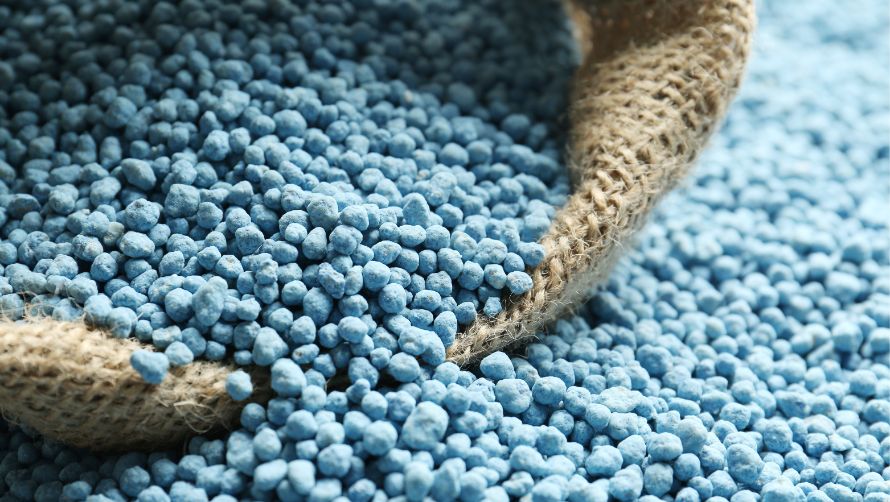
Ammonia production through the Haber-Bosch process is a critical operation in the fertilizer industry. The process begins with the reforming of natural gas (methane) to produce hydrogen. This hydrogen is then combined with nitrogen from the air in a high-pressure, high-temperature environment. Typically, the process operates at pressures of 150–300 bar and temperatures ranging from 400–500°C, with an iron catalyst facilitating the synthesis of ammonia (NH₃). After ammonia is synthesized, it is cooled and condensed into a liquid for storage and distribution. The process also includes multiple stages such as shift conversion (to adjust hydrogen to the correct ratio), CO₂ removal (to prevent catalyst poisoning), and methanation (removal of excess carbon monoxide). Ammonia production is energy-intensive and requires careful handling of gases and temperatures to ensure efficiency and safety.
Types of Gases Present
Ammonia (NH3) : Toxic, corrosive, and pungent; causes respiratory irritation and environmental damage.
Hydrogen (H2) : Highly flammable and explosive in air, particularly in the presence of oxygen.
Carbon Monoxide (CO) : Toxic, colorless, odorless gas that is hazardous even in low concentrations.
Methane (CH4) : Flammable gas, also an asphyxiant in confined spaces.
Carbon Dioxide (CO2): Asphyxiant in high concentrations, also a byproduct of the reforming process.
Nitrogen (N2) : Inert, but can displace oxygen in confined spaces, posing a suffocation hazard.
Reformer Units & Heat Exchangers
Reformation of methane occurs at high temperatures and pressures, and the equipment involved is subject to wear and tear, corrosion, and gasket failures. Leaks can occur in reformer vessels, flue gas ducts, or heat exchangers. These leaks may release hydrogen, methane, or carbon monoxide.
Fixed Point Detectors: Fixed H₂, CH₄, and CO detectors should be installed near burners, flue gas ducts, reformer casings, and heat exchanger units for continuous monitoring.
Portable Detectors: Portable detectors should be used during maintenance, visual inspections, and refractory checks to assess potential leaks that might not be detected by fixed systems.
Synthesis Reactors & Compressors
The ammonia synthesis reactors operate under extreme pressure and high temperature. Seals, joints, and relief valves are vulnerable to wear, potentially leading to leaks of ammonia, hydrogen, or carbon monoxide.
Fixed Point Detectors: NH₃ and H₂ detectors should be placed around compressors, relief valve vents, and reactor outlets. These areas are high-risk, and continuous monitoring is vital.
Portable Detectors: Portable NH₃ detectors should be used during seal checks, confined space entry, and valve inspections, especially during maintenance or repair work.
Methanation Unit & Purification Systems
The methanation process involves converting carbon monoxide into methane, which, if not properly managed, can leak. In addition, purification systems used to remove impurities may release hydrogen or carbon monoxide.
Fixed Point Detectors: Fixed H₂ and CO detectors should be placed around methanation reactors, filtration units, and gas purification systems. Continuous monitoring is necessary to ensure no leaks of these flammable and toxic gases.
Portable Detectors: Portable detectors should be used when replacing catalysts, during routine maintenance, and when checking gas flow systems for leaks.
Ammonia Storage Tanks & Transfer Lines
Ammonia is stored under pressure, and over time, storage tanks, transfer lines, and valves may degrade or suffer mechanical failure, leading to ammonia leaks. Ammonia leakage from storage tanks can be dangerous, as it is both toxic and flammable.
Fixed Point Detectors: Install NH₃ detectors around ammonia storage tanks, transfer lines, and tank venting systems. Fixed detectors should monitor for leaks continuously, especially around high-risk areas like tank inlets, vents, and valve connections.
Portable Detectors: Portable detectors should be used for inspection of storage tanks, during pressure testing, and leak detection in confined spaces
Nitric Acid Production (Ostwald Process)

Nitric acid (HNO₃) is a key intermediate in the production of nitrogen-based fertilizers such as ammonium nitrate. The Ostwald process is the standard industrial method for producing nitric acid from ammonia (NH₃). In this process, ammonia is first oxidized in the presence of a platinum-rhodium catalyst at around 800–950°C to produce nitric oxide (NO). This is followed by further oxidation to nitrogen dioxide (NO₂), and then absorption in water to form nitric acid. The process operates at medium pressure (typically 5–10 atm) and involves stages like ammonia vaporization, catalytic oxidation, cooling, absorption, and acid concentration. The highly exothermic nature of the reactions demands stringent control of temperature and flow, and any leak can release toxic and corrosive gases, making gas monitoring critical.
Types of Gases Present
Ammonia (NH3) : Toxic, pungent gas; causes respiratory irritation and corrosion
Nitric Oxide (NO) : Toxic and reactive; converts to NO₂ upon exposure to air.
Nitrogen Dioxide (NO2) : Highly toxic, reddish-brown gas; causes severe respiratory issues.
Nitrous Oxide (N2O) : Greenhouse gas; asphyxiant at high concentrations.
Hydrogen (H2) : Flammable; may be present from upstream ammonia feed systems.
Oxygen (O2) : Supports combustion; presence may increase fire/explosion risk in leaks.
Ammonia Vaporizer & Preheater Units
Dust and gases such as fluorides and ammonia may be emitted during phosphate rock mixing with sulfuric acid.
Fixed Point Detectors: Install HF, NH₃, and dust detectors near mixing units, conveyors, and hoppers.
Portable Detectors: Used by operators during maintenance, visual inspections, and for confined space entry checks.
Reactor Vessels and Acid Handling
Ammonia reacts with air over a platinum-rhodium catalyst at high temperature to form NO. Leaks can release NO, H₂, or NH₃.
Fixed Point Detectors: Place NO, H₂, and NH₃ detectors around oxidation chambers, catalyst beds, and reaction gas outlets.
Portable Detectors: Useful for detecting leaks during catalyst replacement and post-shutdown inspections.
Gas Cooling & Absorber Towers
Hot gases are cooled, then absorbed in water to form nitric acid. Potential leak sources include pipe flanges, mist eliminators, and acid-resistant linings. NO₂ may escape if absorption is incomplete.
Fixed Point Detectors: Install NO₂ and NO detectors around the absorber tower, acid circulation lines, and stack outlet.
Portable Detectors: Used for routine checks around column internals, drains, and manways.
Acid Storage Tanks & Transfer Pipelines
Nitric acid is stored in lined tanks and transferred through stainless steel or special alloy pipelines. Acid leaks may release NO₂ fumes.
Fixed Point Detectors: Install NO₂ detectors near tank vents, transfer pumps, and loading/unloading stations.
Portable Detectors: For leak checks during hose connections, valve inspections, and confined entry during tank maintenance.
Tail Gas Treatment System
Reduces emissions of NOx gases from absorber exhaust. Failures or leaks can release NO or NO₂.
Fixed Point Detectors: Install NO and NO₂ detectors at tail gas outlets, stack monitoring zones, and scrubber inlet
Portable Detectors: Used during bypass operations, catalyst changes, and emission control audits.
Urea Production

Urea is a widely used nitrogen-based fertilizer produced by reacting ammonia (NH3) with carbon dioxide (CO2) under high pressure and temperature. The process involves two major steps: urea synthesis and urea decomposition. In the synthesis stage, gaseous ammonia and carbon dioxide react at approximately 150–200 bar and 170–200°C to form ammonium carbamate, which is then dehydrated to form urea. The conversion is incomplete, so the unreacted ammonia and CO₂ are recovered and recycled. Urea melt is further processed into prills, granules, or solution for storage and distribution. The process requires precise pressure and temperature control. Leaks can release toxic or asphyxiant gases, especially in the synthesis loop, stripping section, recovery units, and storage systems, making gas detection essential.
Types of Gases Present
Ammonia (NH3) :Toxic, pungent gas; causes respiratory irritation and corrosion
Carbon Dioxide (CO2) : Asphyxiant in confined spaces; high concentrations displace oxygen.
Nitrogen (N2) : Used for purging;can displace oxygen and pose suffocation hazards in confined areas.
High-Pressure Synthesis Reactor
These units recover unconverted ammonia and CO₂ and regenerate them into synthesis feed. They operate at high temperatures, and gasket failure or tube rupture can release toxic vapors.
Fixed Point Detectors: NH₃ and CO₂ detectors should be placed near the stripper column, condenser shell outlets, and vent lines.
Portable Detectors: Used for leak checks during maintenance, flange inspections, and vent line integrity verification.
Carbamate Condensers & Strippers
The reactor combines NH₃ and CO₂ under high pressure to form ammonium carbamate. High-pressure seals, nozzles, and gaskets are common leak points due to mechanical stress and corrosion.
Fixed Point Detectors: Install NH₃ and CO₂ detectors near reactor flanges, pressure relief valves, and around piping connected to the synthesis loop.
Portable Detectors: Use portable NH₃ and CO₂ detectors during inspection of joints, mechanical seals, and while performing confined space entries during shutdowns.
Ammonia Feed & CO2 Compression Lines
The reactor combines NH₃ and CO₂ under high pressure to form ammonium carbamate. High-pressure seals, nozzles, and gaskets are common leak points due to mechanical stress and corrosion.
Fixed Point Detectors: Install NH₃ and CO₂ detectors near valve stations, pump seals, and line manifolds.
Portable Detectors: Use portable NH₃ and CO₂ detectors during inspection of joints, mechanical seals, and while performing confined space entries during shutdowns.
Urea Recovery & Recycle Systems
These systems handle off-gases containing unreacted NH₃ and CO2. Vent stacks and condensate separators may emit residual gas leaks.
Fixed Point Detectors: Install NH₃ and CO₂ detectors near vent stacks, recovery columns, and condensate receivers.
Portable Detectors: Used for stack monitoring, maintenance openings, and condenser inspections.
Urea Storage & Handling Areas
While solid urea is stable, solution storage tanks and prilling/granulation areas may emit NH₃ fumes due to decomposition, especially under high temperatures or spills.
Fixed Point Detectors: NH₃ detectors should be installed near urea melt tanks, granulation towers, and solution loading bays.
Portable Detectors: Used during spill response, inspection of containment areas, and during loading/unloading operations.
Sulfuric Acid Plant

Sulfuric acid (H₂SO₄) is a critical chemical in fertilizer production, especially in the manufacturing of phosphate fertilizers. The most common industrial method is the Contact Process. This involves burning elemental sulfur or sulfur-containing gases (like H₂S or pyrite) to produce sulfur dioxide (SO₂), which is then catalytically oxidized to sulfur trioxide (SO₃) using a vanadium pentoxide (V₂O₅) catalyst at ~400–600°C. SO₃ is then absorbed in water or existing sulfuric acid to form more H₂SO₄. The process includes sulfur melting, combustion, waste heat recovery, gas cooling, catalytic conversion, and absorption. This high-temperature, high-throughput system presents multiple gas leak risks—especially toxic and corrosive SO₂ and SO₃ emissions—necessitating robust gas detection systems.
Types of Gases Present
Sulfur Dioxide (SO₂) :Toxic, pungent gas; causes respiratory problems and environmental damage.
Sulfur Trioxide (SO3) : Highly reactive; forms sulfuric acid mist when combined with water vapor.
Hydrogen Sulfide (H2S) : If sulfur is derived from sour gas or pyrite roasting; extremely toxic and flammable.
Sulfuric Acid Mist (H2SO4 aerosol) : Corrosive to skin, eyes, and respiratory tract.
Oxygen (O2) : Present from process air; supports combustion and can affect sensor calibration.
Nitrogen (N2) : Used for purging; can displace oxygen and pose suffocation hazards in confined areas.
Sulfur Melter & Burner Section
Elemental sulfur is melted and burned with air to produce SO₂. Leaks may occur from flanges, burner seals, or transfer lines due to corrosion or thermal stress.
Fixed Point Detectors: Place SO₂ and H₂S detectors around melters, burner inlets, and sulfur storage tanks.
Portable Detectors: Used for inspections around burner nozzles, melter manways, and thermal insulation areas.
Waste Heat Boiler & Gas Cooling Section
Hot SO₂ gas is cooled using heat recovery systems. Tube leaks or flange failures can release SO₂.
Fixed Point Detectors: Install SO₂ detectors near waste heat boiler flue exits, economizer zones, and cooling duct junctions.
Portable Detectors: Essential for maintenance around exchanger tubes, manholes, and ductwork inspections.
Catalytic Converter (SO2 to SO3)
Gas passes through catalyst beds under high temperature. Leak points include catalyst chamber seals and bypass valves.
Fixed Point Detectors: SO₂ and SO₃ detectors should be positioned near catalyst housing, inlet/outlet ducts, and bypass dampers.
Portable Detectors: For shutdown inspections, catalyst changeovers, and gasket checks.
Absorption Towers
SO₃ is absorbed into circulating sulfuric acid. Mist leaks may occur from seal failures, demister units, or overflows.
Fixed Point Detectors: Deploy SO₃ and H₂SO₄ mist detectors near absorber towers, acid pumps, and vent stacks.
Portable Detectors: Used during acid sampling, demister replacement, and column internals inspection.
Acid Storage Tanks & Transfer Systems
Stored sulfuric acid may fume and release mist or trace SO₂. Leaks occur at pump seals, valves, and hose connections.
Fixed Point Detectors: Place H₂SO₄ mist and SO₂ detectors near tank vents, loading arms, and pump bays.
Portable Detectors: Critical for routine checks during acid transfer, hose couplings, and valve servicing.
Tail Gas Scrubbing System
Removes residual SO₂ or SO₃ from stack gases. Leaks in scrubbers or blowers can release harmful gases.
Fixed Point Detectors: SO₂ detectors should be placed around scrubber fans, outlet stacks, and drain sumps.
Portable Detectors: Used for scrubber packing inspections, pH control system maintenance, and stack emission checks.
Air Separation Units
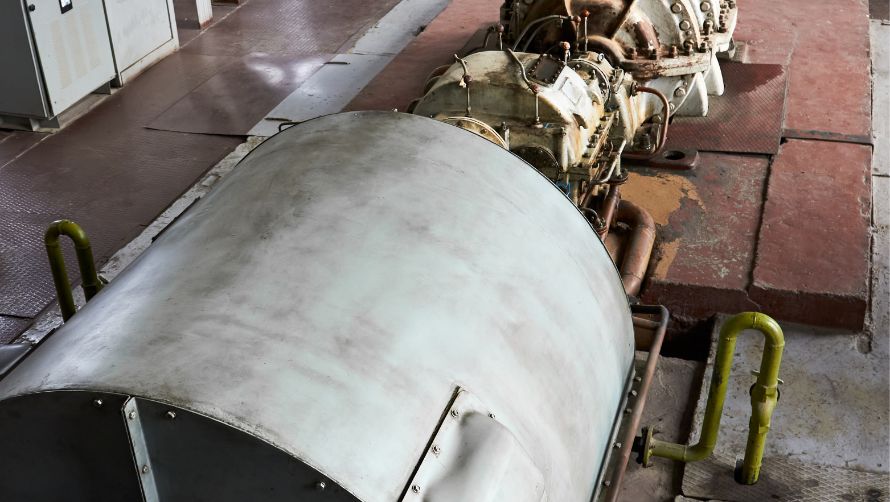
Air Separation Units (ASUs) are essential in fertilizer plants for supplying high-purity nitrogen (N₂) and oxygen (O₂), which are used in processes like ammonia production and nitric acid synthesis. The ASU operates by compressing ambient air, purifying it (removing CO₂ and H₂O), and then cooling it to cryogenic temperatures (~-180°C) to liquefy its components. Fractional distillation is used to separate liquid oxygen, nitrogen, and sometimes argon. The process typically includes stages such as air compression, purification (via molecular sieves), heat exchange, distillation columns, and product storage or delivery systems. Although nitrogen and oxygen are non-toxic, their leakage can cause serious safety hazards like oxygen enrichment (fire risk) or asphyxiation (from oxygen displacement). Therefore, reliable gas detection is vital for both safety and process integrity.
Types of Gases Present
Carbon Dioxide (CO2) : Removed during purification; leaks can cause asphyxiation
Carbon Monoxide (CO): Trace contaminant; toxic if present in air feed or leaks from contaminated compressors.
Hydrocarbons (e.g., CH4) : If present as air impurities, they can condense and pose explosion risks in enriched oxygen environments.
Oxygen (O2) : Oxygen-enriched environments increase the risk of fires and explosions.
Nitrogen (N2) : Inert gas; displaces oxygen and causes asphyxiation in confined areas.
Air Compressor and Pre-Purification Unit (PPU)
Compresses large volumes of air and removes moisture and CO₂ using molecular sieves. Leaks may occur in filters, valves, or purge lines
Fixed Point Detectors: Install CO₂ and CO detectors near filter housings, regeneration heaters, and vent lines.
Portable Detectors: Used for inspection of absorber vessels, valves, and control panel instrumentation.
Cold Box (Heat Exchanger & Distillation Column Section)
Operates at cryogenic temperatures; nitrogen and oxygen are separated here. Vacuum insulation failures or piping cracks may cause N₂ or O₂ leaks.
Fixed Point Detectors: Install O₂ detectors around the cold box perimeter, particularly near liquid oxygen lines and column exits.
Portable Detectors: : Used during cold box access, insulation inspection, and thermal cycling maintenance.
Liquid Oxygen and Nitrogen Storage Tanks
LOX and LIN tanks store liquefied gases at cryogenic temperatures. Valve or flange leaks can result in localized oxygen enrichment or nitrogen build-up.
Fixed Point Detectors: : Install O₂ and N₂ detectors near tank relief valves, vent stacks, and tank truck filling points.
Portable Detectors: :Used during manual filling, de-icing checks, and inspection of overpressure protection devices
Distribution Pipelines to Process Units
Pipelines transport gaseous or liquid N₂ and O₂ to units like ammonia or nitric acid plants. Leaks may occur at flanges, joints, or damaged insulation.
Fixed Point Detectors: O₂ detectors near oxygen lines; N₂ detectors near nitrogen headers, especially in enclosed corridors.
Portable Detectors: Essential during flange maintenance, insulation removal, or inspection of inaccessible pipe racks.
Vaporizer and Pump Areas
Vaporizers and cryogenic pumps convert liquid gases to gaseous form for delivery. Rapid vapor release due to failure can lead to atmospheric oxygen or nitrogen imbalance.
Fixed Point Detectors: O₂ detectors near LOX vaporizers and transfer pumps; N₂ detectors near LIN systems.
Portable Detectors: Used during pump alignment, startup checks, and post-maintenance inspections.
Fertilizer Formation
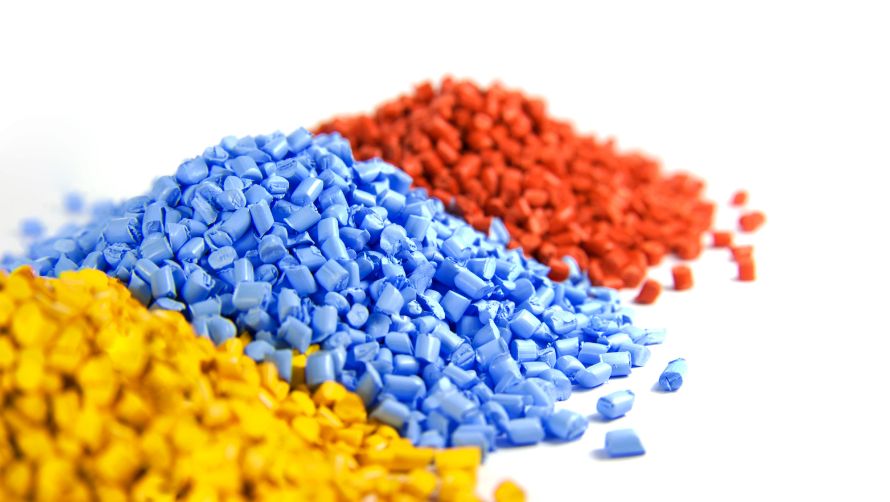
Fertilizer formation is the final stage in fertilizer manufacturing, where raw materials such as ammonium nitrate, urea, phosphates, and potassium compounds are chemically or physically processed into solid or liquid fertilizers in usable forms. Common methods include granulation, prilling, blending, compaction, and slurry formation. For solid fertilizers, granulation involves the agglomeration of powdered or slurry-based chemicals into granules using rotating drums or fluidized beds, followed by drying and cooling. Prilling involves forming droplets of molten material that solidify into small spheres. These steps often require precise temperature control, steam injection, and the use of anti-caking agents. Emissions and leaks of ammonia, dusts, and acidic vapors can occur, making gas leak detection essential for ensuring product quality, operational safety, and environmental compliance.
Types of Gases Present
Ammonia (NH3): Toxic and pungent; leaks occur from slurry preparation, granulators, and urea-based formulations.
Nitric Oxides (NOx) : Can form during ammonium nitrate handling; toxic and corrosive.
Dusts & Particulates (e.g., Urea, AN, SSP): Not gases but airborne solids that irritate respiratory systems.
Sulfur Dioxide (SO2) : From phosphate or sulfate-based fertilizers if sulfuric acid is present.
Volatile Organic Compounds (VOCs): If coatings or additives are used for anti-caking or stabilization.
Nitrogen (N2) : Used for blanketing or purging; can cause asphyxiation in enclosed zones.
Granulation Drums & Mixers
High-speed mixing and steam injection can cause ammonia or acid vapors to escape from seals or vent ducts.
Fixed Point Detectors: Install NH₃ and SO₂ detectors near granulator hoods, slurry inlets, and vaporizers.
Portable Detectors: Used during cleaning, inspection of drum linings, and slurry preparation lines.
Prilling Towers
Molten fertilizer droplets are released from height and solidify mid-air; fumes and gases may accumulate at the top and base.
Fixed Point Detectors: NH₃ and NOₓ detectors at the tower base and top vents; dust monitoring near cyclone or scrubber outlets.
Portable Detectors: : Used during maintenance inside towers, during sprayer nozzle inspection, and for stack monitoring.
Dryers & Coolers
Hot gases are used to dry granules; improper venting or seal failure may lead to gas or dust escape.
Fixed Point Detectors: : NH₃, CO₂, and dust detectors near gas exhaust ducts, rotary dryers, and bag filters.
Portable Detectors: : Used to verify emissions during shutdowns, fan inspections, and ducting repairs.
Dust Collection Systems (Bag Filters & Cyclones)
Handle large volumes of fine particulate matter that may carry traces of volatile components
Fixed Point Detectors: Place dust and NH₃ detectors near baghouse outlets, purge vents, and hopper discharges.
Portable Detectors: Used during filter replacement, hopper cleaning, and emission point testing.
Packaging and Bulk Handling Areas
Product handling in silos, conveyors, and bagging units may generate ammonia-laden dust or residual gases
Fixed Point Detectors: NH₃ detectors near silo tops, conveyor transfers, and automated packing areas.
Portable Detectors: Used during belt maintenance, sealing system inspection, and confined storage entry.
Fume Scrubbers and Vent Stacks
Scrubbers clean process gases before release; leaks or poor scrubbing efficiency may release NOₓ or NH₃.
Fixed Point Detectors: NOₓ and NH₃ detectors near scrubber outlets, stack bases, and drain sumps.
Portable Detectors: Used during neutralizer tank maintenance, mist eliminator inspection, and pH control checks.
Coating and Slow-Release Formulations
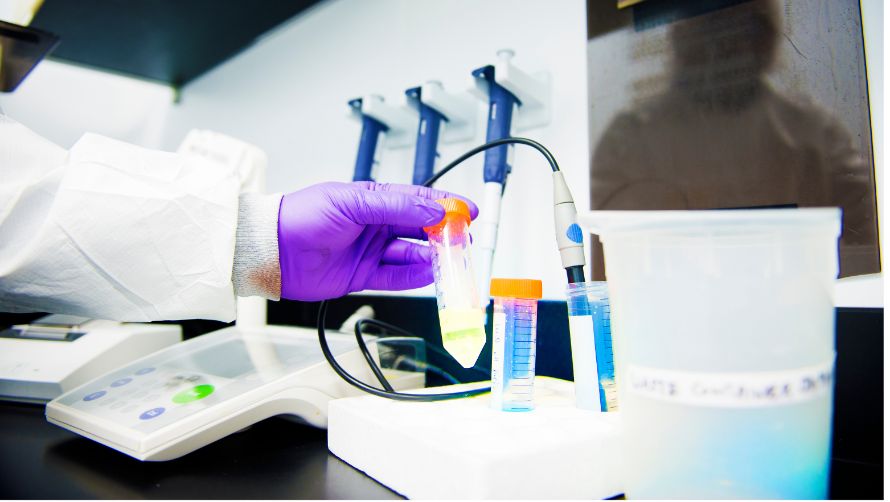
Coating and slow-release formulation is a specialized stage in fertilizer manufacturing where conventional fertilizers (like urea, NPK, or ammonium nitrate granules) are coated with materials that control the nutrient release rate. This improves nutrient efficiency and reduces environmental loss. Common coating materials include sulfur, polymers, waxes, or a combination thereof. The process involves tumbling fertilizer granules in rotating drums while applying coating agents through spraying systems, often heated. For sulfur-coated urea (SCU), molten sulfur is applied, and sometimes a sealant (e.g., wax or micro-polymer) is added to prevent cracks. In polymer-coated fertilizers, synthetic resins are sprayed to form a diffusion-controlling membrane. VOCs, ammonia, and dust emissions may occur during heating, coating, and curing steps. Efficient gas detection is necessary for health, fire safety, and air quality control.
Types of Gases Present
Ammonia (NH3): May be emitted from urea granules during coating, especially when heated
Dusts & Particulates (e.g., Urea, AN, SSP): Airborne particles that irritate respiratory systems.
Sulfur Dioxide (SO2) : Produced during oxidation of molten sulfur; toxic and irritating to eyes and lungs.
Volatile Organic Compounds (VOCs): Released from polymer coatings, solvents, and sealants; flammable and harmful to health.
Hydrogen Sulfide (H2S) : Can evolve in trace amounts during molten sulfur handling; toxic and flammable.
Coating Drums & Spraying Units
Rotating drums where molten sulfur or polymer coatings are applied to granules. Leaks may occur from spray nozzles, heating units, or drum seals.
Fixed Point Detectors: Install VOC, SO₂, and NH₃ detectors around drum enclosures, spray manifolds, and heated reservoirs.
Portable Detectors: Used during drum access, nozzle cleaning, and inspection of coating layer integrity.
Molten Sulfur Tanks & Heating Systems
Tanks and pipelines store and transfer molten sulfur at ~120–150°C. Leaks may emit SO₂ or H₂S, especially near pumps and joints.
Fixed Point Detectors: Install SO₂ and H₂S detectors near tanks, pump rooms, and flange points.
Portable Detectors: : Used during tank cleaning, line insulation checks, and sulfur pit entry.
Polymer Coating Stations
Utilize VOC-based sprays or resins for coating; leaks may occur from pressurized systems or solvent tanks.
Fixed Point Detectors: : VOC detectors near resin feed lines, spray booths, and ventilation outlets.
Portable Detectors: : Used during canister changes, filter replacement, and duct cleaning.
Drying and Curing Sections
Heated air is used to dry or cure the coated product. Gaseous residues from coatings may be released if airflow is inadequate.
Fixed Point Detectors: VOC and NH₃ detectors near hot air outlets, fans, and product discharge conveyors.
Portable Detectors: Used during heater inspection, air duct cleaning, and thermal system calibration.
Dust Handling and Scrubbing Units
Dust collection systems and wet scrubbers manage fine particulate and residual gas emissions. Malfunctions may release NH₃ or VOCs.
Fixed Point Detectors: NH₃, SO₂, and dust detectors near cyclone outlets, scrubber vents, and recirculation pumps.
Portable Detectors: Used during scrubber cleaning, dust collector bag replacement, and gas stack monitoring.
Storage and Packaging Areas for Coated Products
Coated fertilizers can emit residual VOCs or ammonia, especially in warm or poorly ventilated conditions.
Fixed Point Detectors: VOC and NH₃ detectors at silo tops, warehouse entries, and automated bagging stations.
Portable Detectors: Used during bag sealing checks, packaging system inspection, and confined warehouse access.
Drying and Cooling

Drying and cooling is a critical stage in fertilizer production where moisture is removed from freshly formed granules (e.g., from granulation or prilling) and the product is cooled to a stable temperature suitable for storage and handling. Drying is typically performed using rotary drum dryers, fluidized bed dryers, or flash dryers that use hot gases (often combustion air or steam-heated air). Cooling is achieved using rotary coolers or fluidized bed coolers where ambient or conditioned air is circulated. This stage helps achieve desired granule hardness, reduce caking, and prevent decomposition during storage. Gaseous emissions such as ammonia, water vapor, fine dusts, and combustion byproducts (e.g., CO, NOₓ) are common, especially when drying urea, ammonium nitrate, or phosphate-based fertilizers. Proper gas detection ensures safety, prevents inhalation hazards, and maintains environmental compliance.
Types of Gases Present
Ammonia (NH3): Released from urea-based or ammonium-containing materials during drying.
Carbon Monoxide (CO) : Can be present from combustion gases used in hot air generation
Nitric Oxides (NOx) : Emitted from fossil fuel combustion in drying systems.
Dusts & Particulates: Fertilizer dust (e.g., urea, phosphate, NPK); causes respiratory issues.
Sulfur Dioxide (SO2) : Possible if sulfur-based fertilizers are dried using direct flame systems.
Volatile Organic Compounds (VOCs): Trace emissions from coatings or additives during drying
Rotary Dryers and Hot Air Generators
Rotary drum dryers with burners or steam-heated air may leak combustion gases, ammonia, or VOCs. Seals, duct joints, and burner chambers are common leak areas.
Fixed Point Detectors: Install NH₃, CO, and NOₓ detectors near burner assemblies, air inlets, and discharge points.
Portable Detectors: Used during refractory inspection, burner maintenance, and emission surveys.
Fluidized Bed Dryers
Use fluidizing air and heat for drying fine particles. Turbulence can cause dust, NH₃, and VOC emissions if not well-contained
Fixed Point Detectors: Place NH₃ and dust detectors near exhaust ducts and fluidizing air blowers.
Portable Detectors: :For spot-checking leaks during blower checks and bed fluidization inspections.
Coolers (Rotary or Fluidized Bed Type)
Use ambient or cooled air to reduce fertilizer temperature. Leaks may occur at ducts, outlet hoppers, and fan housings.
Fixed Point Detectors: : Dust and NH₃ detectors at air intake and exhaust zones.
Portable Detectors: : Used during cleaning of cooler sections, airflow adjustments, or screen maintenance.
Dust Collection Systems (Cyclones, Baghouses, Scrubbers)
Capture fine particulate matter and fumes from drying and cooling systems. Overloads or filter failures can cause emissions.
Fixed Point Detectors: Install dust, NH₃, and VOC detectors at cyclone outlets, bag filters, and scrubber vents.
Portable Detectors: Used during filter bag replacement, hopper discharge inspection, and differential pressure testing.
Air Handling and Ventilation Ducts
Carry processed air; duct leaks can release NH₃, dust, or CO. Corrosion or improper sealing are common leak causes.
Fixed Point Detectors: NH₃, CO, and dust detectors near major duct branches, elbows, and terminal vents.
Portable Detectors: Useful for duct inspection, flange leak testing, and fan housing assessments.
Product Discharge and Conveying Systems
Dried/cool granules may release residual gases or dust during transfer. Leaks may occur at chute seals and transfer points.
Fixed Point Detectors: Dust and NH₃ detectors near conveyor outlets, bucket elevators, and screening units.
Portable Detectors: Used during belt maintenance, vibration checks, and bin discharge cleaning.
Utility Generation and Supply Systems

Utility generation and supply systems are crucial to the overall functioning of fertilizer production facilities. These systems provide essential utilities like electricity, steam, water, compressed air, and nitrogen, all of which are needed for various stages of the manufacturing process. Common systems include steam boilers, gas turbines, air compressors, and water treatment units. Steam is used for heating and drying, while compressed air is often utilized for conveying materials and controlling equipment. Water treatment systems ensure clean water for production processes, and nitrogen generation systems supply inert gas for applications such as blanketing and purging. Given the large volume of utilities required and the complexity of their distribution, these systems are susceptible to gas leaks, especially from pressurized systems, combustion units, and cooling towers. Proper detection and monitoring are essential for ensuring operational safety, avoiding leaks, and maintaining system efficiency.
Types of Gases Present
Ammonia (NH3): Leaks from nitrogen generation units or associated pipes and fittings.
Carbon Monoxide (CO) : A byproduct of incomplete combustion; highly toxic and odorless.
Nitric Oxides (NOx) : Formed during combustion; contributes to air pollution and acid rain.
Sulfur Dioxide (SO2) : Released during sulfur-containing fuel combustion in boilers or turbines
Carbon Dioxide (CO2) : Produced by combustion processes in boilers and turbines; may accumulate in confined spaces.
Hydrogen (H2) : Leaked from hydrogen generation or storage systems, flammable and explosive.
Oxygen (O2) : Can leak from air separation units or in oxygen-rich environments, posing a fire risk.
Inert Gases (e.g., N₂) : Used in blanketing, purging, or inerting systems; can cause asphyxiation in confined spaces.
Boilers & Combustion Units
Boilers burn fuel (e.g., natural gas, oil, or coal) to generate steam. Leaks may occur at fuel lines, burners, or exhaust stacks, releasing CO, NOₓ, or CO₂.
Fixed Point Detectors: Install CO, CO₂, and NOₓ detectors near burner areas, flue gas stacks, and combustion chambers.
Portable Detectors: Used for leak testing, burner inspections, and during fuel supply line maintenance.
Air Compressors & Compressed Air Systems
Compressors generate high-pressure air, which can leak from seals, pipes, or valves. Leaks may release oils, particulate matter, or small quantities of ammonia (if used for certain processes).
Fixed Point Detectors: Place pressure and ammonia detectors at key points in compressor rooms, along air lines, and near filter outlets.
Portable Detectors: : Used during routine maintenance and compressor inspection, especially at seal points and pressure regulators.
Nitrogen Generation Units (PSA/ASU)
Nitrogen is often generated by air separation units (ASUs) or pressure swing adsorption (PSA) systems. Leaks can occur from pipes, valves, or storage tanks, releasing nitrogen gas. While nitrogen is inert, it displaces oxygen and may cause asphyxiation in confined spaces.
Fixed Point Detectors: : Install oxygen and nitrogen detectors near storage tanks, compressors, and purging units.
Portable Detectors: : Used during routine inspections of purging and venting systems, and for confined space monitoring.
Water Treatment Systems
Water treatment units, such as demineralizers or reverse osmosis systems, may release CO₂ from carbonation processes or use chemical agents that could leak as gases (e.g., chlorine or ammonia).
Fixed Point Detectors: Install CO₂, ammonia, or chlorine detectors near chemical dosing systems, vents, and discharge points.
Portable Detectors: Used during cleaning, pipe inspections, and when monitoring chemical agent tanks.
Cooling Towers & Heat Exchangers
Cooling towers release warm air and vaporized water. Leaks can involve cooling fluids or chemicals used for heat exchange, potentially releasing ammonia or VOCs.
Fixed Point Detectors: Install NH₃, CO₂, and VOC detectors near heat exchange zones, cooling towers, and condenser units.
Portable Detectors: Used during water flow inspections, cooling tower maintenance, and pressure system checks.
Steam Distribution Systems
Steam pipes and valves may leak steam or condensate, resulting in energy losses or hazardous conditions. Pressure relief valves and condensate recovery systems are potential leak points.
Fixed Point Detectors: Install steam, CO₂, and oxygen detectors near pressure relief valves, steam lines, and condensate traps.
Portable Detectors: Used for routine inspections of pressure release valves, steam pipe joints, and condensate drains.
Fuel Supply Lines & Storage
Fuel lines (natural gas, oil, etc.) supplying combustion systems are vulnerable to leaks, especially at joints, valves, and storage tanks. Leaks can release CO, CO₂, and VOCs.
Fixed Point Detectors: Install CO, CO₂, and VOC detectors near storage tanks, pump stations, and fuel transfer pipelines.
Portable Detectors: Used during fuel tank maintenance, line repairs, and pressure testing.
Gas Scrubbers & Waste Gas Treatment Units
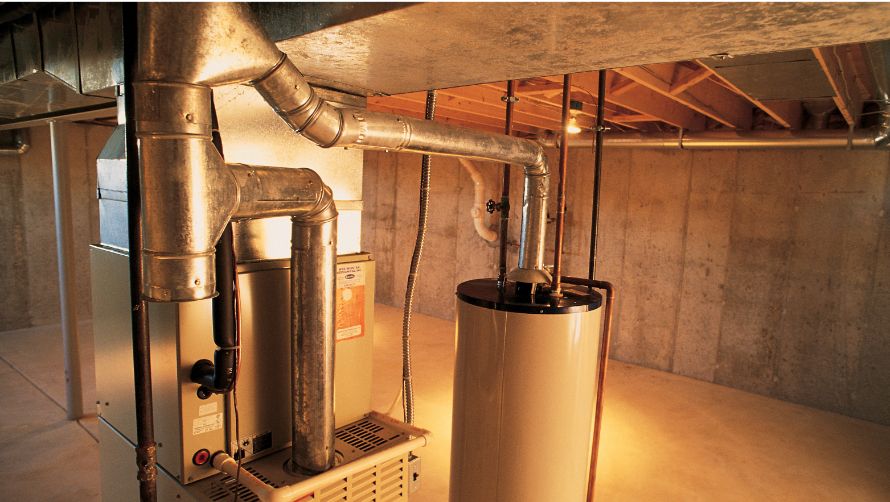
Gas scrubbers and waste gas treatment units are used in fertilizer manufacturing plants to control and treat gases emitted during production processes. These systems are primarily designed to remove pollutants, including sulfur compounds, ammonia, volatile organic compounds (VOCs), and particulates from exhaust gases before they are released into the atmosphere. Scrubbing can be achieved using water, alkaline solutions, or chemical absorbents, depending on the nature of the gases being treated. Waste gas treatment often involves a multi-stage process, including wet scrubbing, chemical absorption, and sometimes thermal treatment to neutralize hazardous gases. These systems are essential for compliance with environmental regulations, ensuring that emissions are minimized and the air quality is maintained. Given the use of chemicals and high pressures, gas leaks can occur at various points, requiring effective gas detection systems to ensure worker safety and compliance.
Types of Gases Present
Ammonia (NH3): Released from scrubbing units, particularly when treating exhaust gases from urea production or ammonia synthesis.
Hydrogen Sulfide (H2S) : Evolved during the treatment of sulfur-containing gases; highly toxic and flammable
Nitric Oxides (NOx) : Present in some exhaust gases, particularly if combustion processes are involved.
Sulfur Dioxide (SO2) : Emitted from sulfur removal processes and can be released if scrubbers malfunction.
Carbon Dioxide (CO2) : Often emitted from neutralizing or scrubbing processes that treat acidic gases.
Volatile Organic Compounds (VOCs) : Released from chemical reactions or leakage of treatment fluids.
Chlorine (Cl2) : May leak from scrubbers treating chlorine-containing gases, especially in cases of chlorine injection systems.
Scrubber Vessels
Scrubbers often use water or chemical solutions to absorb harmful gases. Leaks may occur due to pressure relief valves, tank seals, or the system’s piping.
Fixed Point Detectors: Install NH₃, H₂S, and VOC detectors around the scrubber vessel and associated piping systems. Detectors should also be placed near drainage outlets or venting stacks.
Portable Detectors: Used for routine maintenance, inspection of seals, and monitoring chemical levels during system cleaning.
Pumps & Chemical Feed Lines
Pumps are used to circulate scrubber solutions, while chemical feed lines deliver neutralizing agents. Leaks may occur at seals, valves, or pipe joints, particularly in high-pressure areas.
Fixed Point Detectors: VOC, H₂S, and NH₃ detectors should be installed near pump areas, chemical feed points, and valve connections.
Portable Detectors: : Used during pump maintenance, pressure testing, and to monitor fugitive emissions from chemical feed systems.
Absorber Columns
Absorber columns are used to treat exhaust gases by passing them through liquid scrubbing solutions. Malfunctions or overflows can lead to gas leaks, particularly VOCs or ammonia.
Fixed Point Detectors: : Install VOC, NH₃, and SO₂ detectors at the top and bottom of absorber columns, near gas outlets, and around the liquid distributor system.
Portable Detectors: : Used during inspections of column internals, liquid flow checks, and scrubber outlet monitoring.
Exhaust & Ventilation Systems
The treated gas is vented out through exhaust ducts. Leaks may occur at connections, venting pipes, or scrubber exhaust stacks. Emissions such as H₂S, NH₃, and VOCs may be present.
Fixed Point Detectors: Install H₂S, NH₃, and VOC detectors at duct junctions, exhaust vents, and stack outlets.
Portable Detectors: Used during stack inspections, system purging, and to monitor fugitive emissions around venting areas.
Pressure Relief Valves & Flanged Connections
Pressure relief valves are critical safety components in scrubbing systems. If there is an overpressure, gases such as NH₃ or VOCs can leak through these relief points.
Fixed Point Detectors: NH₃ and VOC detectors should be placed near pressure relief valves, flanged connections, and the vent lines leading to the atmosphere.
Portable Detectors: Used during valve maintenance, pressure testing, and when inspecting gasket integrity or flange connections.
Scrubber Drainage and Disposal Systems
Scrubber solutions and treated water are typically drained into disposal or recycling systems. Leaks may occur during the disposal of these solutions, potentially releasing gases like NH₃, VOCs, or SO₂.
Fixed Point Detectors: Install NH₃, VOC, and SO₂ detectors around the drainage pipes and treatment tanks.
Portable Detectors: Used during drainage system cleaning, inspections, and when monitoring chemical waste storage tanks.
Re-circulation and Pumping Systems
Re-circulating systems pump the scrubbing liquid back into the scrubber for reuse. Leaks in pump seals or pipe joints may lead to chemical spills or gas emissions.
Fixed Point Detectors: Install VOC, NH₃, and H₂S detectors at re-circulation pump stations, flow meters, and pipe joints.
Portable Detectors: Used during system maintenance, chemical level checks, and in confined space entry for pump repairs.
Packaging and Storage and Handling

Packaging, storage, and handling are critical stages in the fertilizer production process, where the final product is prepared for shipment to customers or storage in warehouses. Fertilizers are typically packaged in bags, bulk containers, or in some cases, stored in silos or tanks. This process involves material handling systems, conveyors, forklifts, and automated packaging lines to load and unload products. During storage, fertilizers may be kept in large bulk storage units, silos, or warehouses, while handling involves the transportation of finished products to different locations for distribution. Proper ventilation, temperature control, and moisture management are essential to prevent the degradation of fertilizers and to ensure safety, particularly when dealing with volatile materials. The storage and handling areas are also prone to gas leaks, especially in poorly ventilated areas or where hazardous gases like ammonia, VOCs, or chlorine may be used or produced in the process.
Types of Gases Present
Ammonia (NH3): Leaked from bagging or storage systems for nitrogen-based fertilizers, can be pungent and hazardous to health
Hydrogen Sulfide (H2S) : A potential emission in the handling of sulfur-containing fertilizers or certain packaging materials
Nitric Oxides (NOx) : Can be released from combustion systems used for drying or packaging processes
Dust Particles : Although not a gas, airborne particulate matter from fertilizers (such as ammonium nitrate or urea) can pose significant health hazards
Carbon Dioxide (CO2) : Released in some fertilizer products or from combustion processes in storage and handling areas.
Volatile Organic Compounds (VOCs) : Emitted from packaging materials, adhesives, or containers; may be hazardous.
Chlorine (Cl2) : May be released from the handling of chlorine-based fertilizers or disinfectants used during packaging.
Hydrogen (H2) : Leaked from pressurized gas storage systems or used in certain handling processes.
Packaging Lines
Packaging lines are often equipped with automated systems that seal, label, and bag fertilizer products. Leaks can occur from the pressurized packaging equipment, conveyors, and sealing machines.
Fixed Point Detectors: VOC, NH₃, and CO₂ detectors should be installed near packaging machines, sealing stations, and conveyor lines where fertilizers are bagged.
Portable Detectors: Used for routine checks around conveyor systems, at loading/unloading points, and during maintenance to ensure no gas leaks during the sealing process
Bulk Storage Silos
Fertilizers like ammonium nitrate or urea are often stored in bulk silos. These units may have ventilation or dust collection systems that could leak gases or particles.
Fixed Point Detectors: Install NH₃, VOC, and CO₂ detectors at ventilation outlets, silo hoppers, and material transfer points.
Portable Detectors: : Used during silo maintenance, product handling, and to check for leaks at silo discharge points.
Warehouse Storage Areas
Warehouses store packed fertilizer bags or bulk containers. Gas leaks can occur from improper storage conditions or equipment malfunctions, particularly with nitrogen-based or chlorine-based fertilizers.
Fixed Point Detectors: Install NH₃, VOC, and CO₂ detectors near storage areas, ventilation systems, and loading/unloading docks.
Portable Detectors: : Used during routine warehouse inspections, particularly around areas where materials are stacked or moved. They can help monitor leaks or gas buildup in confined spaces.
Forklift & Transportation Equipment
Forklifts and transportation equipment used in storage and handling can have exhaust systems that may leak gases like CO, CO₂, or VOCs
Fixed Point Detectors: Install CO and CO₂ detectors in areas with heavy forklift activity, especially in confined or poorly ventilated spaces.
Portable Detectors: Used during equipment inspections and maintenance to monitor exhaust emissions or leaks from fuel systems.
Transfer & Loading Stations
Fertilizer is transferred to trucks or railcars for shipment. Gaseous emissions may arise from material spillage or from fertilizers stored in open containers.
Fixed Point Detectors: Install NH₃ and VOC detectors near transfer stations, loading arms, and railcar filling ports.
Portable Detectors: Used for routine inspections at the loading points, especially when transferring materials to open containers or trucks.
Ventilation & Air Handling Units
Ventilation systems are crucial for maintaining air quality in storage and handling areas. Leaks can occur from damaged ventilation ducts, filters, or exhaust systems, potentially releasing hazardous gases
Fixed Point Detectors: Install VOC, NH₃, and CO₂ detectors near air vents, exhaust stacks, and air handling units.
Portable Detectors: Used for inspecting ductwork, vents, and air filtration systems during maintenance.
Dust Collection Systems
Dust collection systems are essential in minimizing airborne particulate matter during fertilizer handling. Leaks or malfunctions in dust collectors can lead to the release of hazardous fertilizers, which may include small amounts of VOCs or ammonia.
Fixed Point Detectors: Install dust detectors, VOC, and NH₃ detectors near collection bins, dust collector hoppers, and filter systems.
Portable Detectors: Used during system cleaning and inspection, particularly around filter systems and material transfer areas
Chlorine Handling and Storage
Chlorine is used in some fertilizers or as part of the disinfection process. Leaks can occur from storage tanks, delivery lines, or during handling operations.
Fixed Point Detectors: Install chlorine detectors in areas where chlorine is stored or transferred, including gas lines, tanks, and shipping containers
Portable Detectors: Used for leak detection during unloading and storage tank maintenance.
Wastewater & Effluent Treatment Units

Wastewater and effluent treatment units are essential in fertilizer plants to treat and manage industrial wastewater before it is released into the environment or reused within the plant. Fertilizer production often involves the use of chemicals, high temperatures, and water-intensive processes, all of which result in the generation of wastewater that may contain contaminants such as ammonia, heavy metals, phosphates, sulfur compounds, and organic matter. Effluent treatment processes typically include physical, chemical, and biological methods to remove or neutralize these contaminants. The treatment includes steps such as coagulation, flocculation, sedimentation, filtration, biological treatment, and sometimes chemical neutralization. In some plants, the treated effluent may be recycled for reuse in certain stages of production. Given the complex chemicals involved and the need to prevent contamination of water bodies, gas leaks can occur during chemical dosing, filtration, or during the handling of treated waste gases. Proper leak detection is critical to maintain safe operations and comply with environmental regulations.
Types of Gases Present
Ammonia (NH3): Released from effluent treatment stages where nitrogen compounds are present in the wastewater.
Hydrogen Sulfide (H2S) : Generated from the anaerobic digestion of organic material in wastewater or when sulfur-containing waste is present.
Nitric Oxides (NOx) : Produced during combustion processes used in the treatment or disposal of effluent.
Sulfur Dioxide (SO2) : Released during the neutralization of sulfur-containing wastewater or during chemical dosing.
Carbon Dioxide (CO2) : Released from biological treatment processes or neutralization steps
Volatile Organic Compounds (VOCs) : Emitted from various stages of treatment, including chemical addition or biological treatment units.
Chlorine (Cl2) : Used in some disinfection processes, with the potential for leakage if not properly controlled.
Methane (CH4) : Can be released during the anaerobic treatment of organic waste or from wastewater storage tanks
Chemical Dosing Systems
Chemical dosing systems are used to add neutralizing agents, coagulants, or flocculants into the wastewater treatment process. Leaks may occur from pump seals, injection points, or supply lines.
Fixed Point Detectors: Install NH₃, H₂S, and VOC detectors at dosing stations, chemical storage tanks, and injection points.
Portable Detectors: Used during routine maintenance, chemical tank inspections, and to monitor for leaks around pump seals and injection ports.
Biological Treatment Units
Biological treatment units, such as activated sludge systems, use microorganisms to break down organic matter in the wastewater. Gases like methane and hydrogen sulfide can be generated during anaerobic digestion
Fixed Point Detectors: Install CH₄, H₂S, and VOC detectors near biological reactors, digesters, and aeration tanks.
Portable Detectors: : Used for inspecting anaerobic digester tanks, checking gas collection points, and monitoring for fugitive emissions during maintenance.
Aeration Systems
Aeration systems are used to supply oxygen to biological treatment units. Air leaks or failures in compressors can lead to pressure buildup and potential gas leaks.
Fixed Point Detectors: Install CO₂ and VOC detectors around aeration tanks, compressors, and air supply systems.
Portable Detectors: Used for inspecting aeration blowers, checking gas leaks at connection points, and during air flow system maintenance.
Sludge Handling and Dewatering Units
Sludge handling involves removing solid waste from the effluent, followed by dewatering to reduce its volume. Gas emissions like methane or ammonia can occur from sludge storage tanks or during the dewatering process.
Fixed Point Detectors: Install CH₄, NH₃, and VOC detectors at sludge storage tanks, dewatering machines, and filtration units.
Portable Detectors: Used during routine sludge tank maintenance, dewatering inspections, and to monitor fugitive emissions from storage areas.
Effluent Holding Tanks
Effluent holding tanks are used to temporarily store wastewater before further treatment or disposal. Gases like hydrogen sulfide (H₂S) or methane (CH₄) may build up in poorly ventilated tanks.
Fixed Point Detectors: Install H₂S and CH₄ detectors near tank vents, manholes, and discharge points.
Portable Detectors: Used during routine inspections, tank cleaning, and to monitor gas concentrations in confined spaces.
Flotation and Filtration Units
In some treatment plants, flotation or filtration units are used to remove suspended solids or oil from wastewater. Chemical dosing or air injection can create leaks or emissions, especially in high-pressure filtration systems
Fixed Point Detectors: Install VOC, NH₃, and CO₂ detectors near flotation tanks, filter press units, and chemical feed systems
Portable Detectors: Used for inspecting filtration systems, chemical injection points, and checking for leaks during routine maintenance or system upgrades
Effluent Discharge Systems
Treated effluent is typically discharged to the environment via pipelines, ponds, or other outlets. Leaks may occur from discharge pipes or at the outfall, particularly if the effluent contains hazardous gases.
Fixed Point Detectors: Install NH₃, VOC, and SO₂ detectors near discharge pipes, effluent outfalls, and associated storage tanks.
Portable Detectors: Used to inspect discharge points, monitor for gas emissions in open air systems, and ensure that the effluent discharge is within regulated limits.
Chlorination & Disinfection Systems
Chlorine is used in some plants to disinfect wastewater or to neutralize contaminants. Leaks can occur in the chlorine gas cylinders, piping, or the chlorination system.
Fixed Point Detectors: Install chlorine detectors near chlorine gas cylinders, chlorination chambers, and associated piping systems.
Portable Detectors: Used during routine checks of chlorine tanks, piping systems, and during maintenance of disinfection equipment.
Waste Handling and Environmental Control
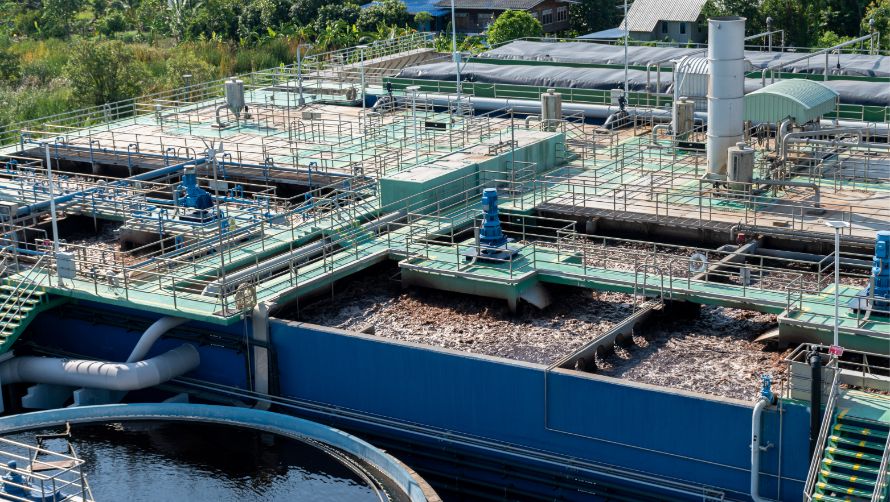
Waste handling and environmental control are integral processes in fertilizer manufacturing to ensure that all waste products, including chemical residues, by-products, and used materials, are properly managed. Fertilizer production often generates both hazardous and non-hazardous waste, which may include spent catalysts, sludge, packaging waste, and various chemical residues. The goal of this process is to minimize environmental impact by managing and treating waste products before they are disposed of or recycled. Environmental control systems are also in place to monitor and regulate emissions, ensuring compliance with air, water, and soil quality standards. These systems involve air filtration, wastewater treatment, and the containment of hazardous materials to prevent spills or leaks. Gas leaks are a potential hazard in waste handling and treatment systems, particularly from volatile substances, toxic gases, and hazardous chemicals. Efficient gas leak detection is crucial in these areas to prevent exposure to harmful substances, ensure safe waste handling, and comply with environmental regulations.
Types of Gases Present
Ammonia (NH3): Released from waste treatment processes, particularly during the breakdown of nitrogen-based fertilizers or residual chemical products.
Hydrogen Sulfide (H2S) : Generated during the decomposition of organic waste or from sulfur-containing compounds in waste streams.
Nitric Oxides (NOx) : Produced during the incineration or thermal treatment of waste containing nitrogen compounds
Sulfur Dioxide (SO2) : Released from the neutralization of sulfur-based waste or during certain combustion processes in waste incineration.
Carbon Dioxide (CO2) : Produced during the combustion of waste, biological decomposition, or chemical reactions within waste management systems.
Volatile Organic Compounds (VOCs) : Emitted from various waste handling operations, including chemical storage, packaging waste, and decomposition of organic matter.
Chlorine (Cl2) : Can be released during the treatment of chlorine-containing chemicals or waste products.Methane (CH4) :A by-product of anaerobic decomposition in waste management, particularly from organic waste treatment or landfill areas
Carbon Monoxide (CO) : Can be emitted from combustion of waste materials or from incomplete combustion processes.
Waste Storage Areas
Waste storage areas are where waste materials, such as sludge, spent chemicals, and organic materials, are kept before processing or disposal. Leaks may occur from poorly sealed containers, storage tanks, or bins.
Fixed Point Detectors: Install NH₃, H₂S, VOC, and CO detectors at waste storage sites, particularly near containers, storage bins, and chemical tanks.
Portable Detectors: Used for spot checks, particularly around waste containment areas, during the transfer of waste materials, and to detect leaks from storage containers
Waste Treatment Units
Waste treatment units, including biological, chemical, and thermal treatment systems, manage and neutralize hazardous waste. Gases such as H₂S, NH₃, and VOCs may be released during the treatment or neutralization of waste.
Fixed Point Detectors: Install NH₃, H₂S, SO₂, and VOC detectors near treatment reactors, neutralization tanks, and incineration units.
Portable Detectors: : Used during system inspections, maintenance, or during routine checks around vents, treatment chambers, and emission points to monitor gas concentrations.
Incineration Units
Aeration systems are used to supply oxygen to biological treatment units. Air leaks or failures in compressors can lead to pressure buildup and potential gas leaks.
Fixed Point Detectors: Install CO₂ and VOC detectors around aeration tanks, compressors, and air supply systems.
Portable Detectors: Used for inspecting aeration blowers, checking gas leaks at connection points, and during air flow system maintenance.
Sludge Handling and Dewatering Units
Incineration is used to treat hazardous waste by burning. This process can generate gases such as CO₂, CO, and NOₓ, particularly if the incineration process is incomplete.
Fixed Point Detectors: Install CO, CO₂, and NOₓ detectors around incinerator stacks, combustion chambers, and exhaust ducts
Portable Detectors: Used to monitor gas emissions during maintenance, inspection of combustion units, and while checking emission points for leaks or inefficiencies in combustion.
Landfills and Anaerobic Digestion Units
Organic waste is often processed through anaerobic digestion or landfilled. Methane and hydrogen sulfide are common by-products of anaerobic decomposition.
Fixed Point Detectors: Install CH₄, H₂S, and VOC detectors near landfill gas collection systems, anaerobic digesters, and venting points.
Portable Detectors: Used during landfill inspections, maintenance of gas collection systems, or when monitoring for potential leaks at vents or collection wells.
Chemical Waste Handling Areas
Fertilizer plants often generate chemical waste, including residues from production processes, spent catalysts, and reagents. Leaks can occur from storage tanks, drums, or handling systems, releasing toxic gases.
Fixed Point Detectors: Install NH₃, SO₂, and VOC detectors near chemical waste containers, transfer lines, and storage tanks.
Portable Detectors: Used for routine checks, inspections of chemical storage, and handling areas where hazardous chemicals are being transferred or processed
Wastewater Treatment Units
Wastewater treatment units handle effluent and waste water generated during fertilizer production. Gases like NH₃, H₂S, and CO₂ are produced during biological treatment, sedimentation, or chemical neutralization of wastewater.
Fixed Point Detectors: Install NH₃, H₂S, CO₂, and VOC detectors around biological treatment tanks, aeration systems, and chemical dosing units.
Portable Detectors: Used during regular checks of wastewater treatment systems, particularly at ventilation points, aeration tanks, and effluent discharge points
Storage Tanks for Hazardous Waste
Hazardous waste materials, including chemical by-products and spent fertilizers, are stored in specialized tanks before being treated or disposed of. Leaks from these tanks may release harmful gases.
Fixed Point Detectors: Install NH₃, H₂S, and VOC detectors at tank vents, inspection ports, and where tanks are connected to waste treatment systems
Portable Detectors: Used during routine inspections of storage tanks, especially during tank cleaning or maintenance to detect any gas leaks from seals or pressure relief valves.
Disposal and Recycling Facilities
Some waste products may be recycled or repurposed in the production process. These areas may produce gases, such as CO₂ or VOCs, during the handling, shredding, or chemical neutralization of waste materials.
Fixed Point Detectors: Install VOC, CO₂, and NH₃ detectors in areas where waste products are being processed, shredded, or neutralized
Portable Detectors: Used for inspections around recycling or disposal areas, particularly when waste materials are processed or when emissions are being filtered out.
